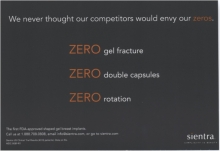“Gel fracture”? In over 1500 gummy bear implants, I’ve never seen it and many surgeons question whether it is clinically relevant or just an artifact from handling when removing a well-adhered, textured implant. Fracture rates are based upon removed implants, rather than on physical examination, so it may be an artifact of removal.
“Double capsule”? I have seen it, but it exists in normal breasts and is of no significance at all.
“Zero Rotation”? Unfortunately, that’s impossible. Implants must move around inside the body; if no rotations were observed, there are two explanations: the first is that Sientra only studied about two hundred patients with shaped implants in its augmentation study, and that is not a large enough sample to determine a rate of something so infrequent. The second is that, though their implant is teardrop-shaped, it is not shaped enough to either be of benefit when it is in the right position or it is a liability when it is in the wrong position. The more exaggerated the shape, the more critical its positioning needs to be, and the more obvious malposition will be. Having an implant that doesn’t make the breast look different when it is malpositioned initially sounds good, but if breast shape is barely changed by implant malposition, then it means that the implant wasn’t shaping the breast successfully when it was in the right position. If one wants an implant that can improve and control shape, then it should be expected that shape will suffer if the implant is out of position.
It may sound as if I am opposed to Sientra, I would say the same of Mentor and Allergan if they were to produce an ad like this!

A true zero is so rare in science that claims of its existence always strain credulity. When smart surgeons hear a manufacturer claim something is zero, they conclude that not enough patients were studied, the results weren’t accurately reported, or the endpoint was subjective.

